Serviceberry: Trees, Shrubs, Leaves, Flowers (Pictures) – Identification

Serviceberry is a group of small deciduous fruit trees or multi-stemmed shrubs with beautiful white flowers that bloom in early spring. Serviceberry trees and shrubs are identified by their long oval leaves with finely serrated edges, clusters of showy white 5-petalled flowers, smooth gray bark, and small round edible purple pome fruits. Serviceberry trees are excellent garden landscaping plants because they have a visual appeal in all four seasons.
A common name for serviceberry is juneberry because the serviceberry fruits start to ripen in June. Other names for serviceberry plants include shadbush, shadblow, Saskatoon, sugarplum, chuckley pear, or wild plum.
This article is a guide to identifying varieties of serviceberry trees and shrubs. Descriptions of these pretty trees and pictures of their flowers, leaves, and berries will help you recognize the shrubs and trees in a landscape.
What Is a Serviceberry (Amelanchier)?
Serviceberry is a common name for trees and shrubs in the genus Amelanchier. Serviceberry bushes or trees have thin stems or trunks, with most species producing suckers and multiple stems. The deciduous, flowering trees and shrubs thrive in full sun to partial shade in USDA zones 4 to 9.
There are 20 species of deciduous trees and shrubs in the genus Amelanchier and rose family Rosaceae. Serviceberries are native to North America and grow widely throughout the United States and Canada.
Serviceberry trees grow between 10 and 25 ft. (3 – 7.5 m) tall and up to 20 ft. (6 m) wide. Serviceberry shrubs are somewhat smaller than the trees. The multi-stemmed serviceberry bushes typically grow between 3 and 6 ft. (1 – 1.8 m) tall and wide. However, some can grow taller.
Serviceberry Trees Identification
Serviceberry trees feature recognizable smooth gray bark, a narrow trunk, and showy white, fragrant flowers with five thin petals forming a star shape.
Serviceberry Leaves
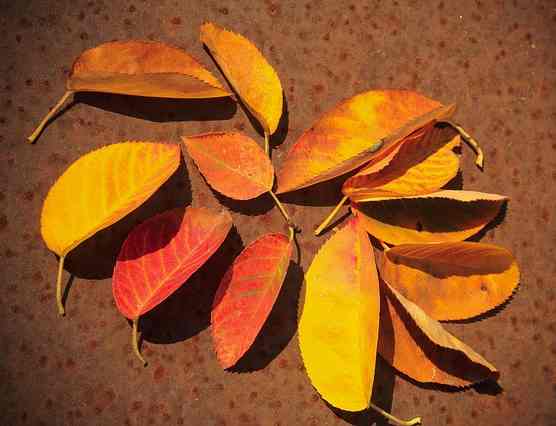
Serviceberry leaves in autumn
Serviceberry leaves are long ovate or lanceolate shaped with finely serrated margins, a pointed tip, and a rounded base. The leaves measure between 3” and 6” (7.5 – 15 cm) long and up to 3” (3.5 cm) wide. In the fall, serviceberry leaves turn warm hues of yellow, orange, and red.
Serviceberry leaves are arranged alternately on stems. You can also recognize serviceberry leaves on immature trees and shrubs by their slightly fuzzy feel.
Serviceberry Flowers

Serviceberry flowers bloom in early spring and are typically white
Serviceberry trees are known for growing masses of fragrant white spring flowers. The attractive ray-like serviceberry flowers have five widely-spaced petals fanning out in a star shape. The serviceberry flowers appear on bare stems, drooping pendulously in small clusters. The flower clusters measure 3” to 6” (7.5 – 15 cm) in size.
Serviceberry flowers are typically white. However, some species of the plant produce pink, yellow, or reddish blossoms. Each cluster can have between four and 20 flowers.
Serviceberry trees are one of the first trees to bloom in early spring, around mid-April. When serviceberries bloom, the tree is covered in clusters of flowers. The white flowers contrasting with the dark gray bark are a stunning sight in garden landscapes. Flowers on serviceberry trees bloom for ten days.
The common names of Amelanchier trees and shrubs refer to the plant’s early blooming time. For example, in early April, when serviceberries bloom, shad (schooling fish) swim up rivers to spawn—hence the names shadbush or shadblow.
Amelanchier tree flowers appear when the ground starts to thaw after winter. The name serviceberry comes from the fact that in early spring when serviceberries start to bloom, people could dig the ground to perform burial services after long, cold winters.
Serviceberry Fruit
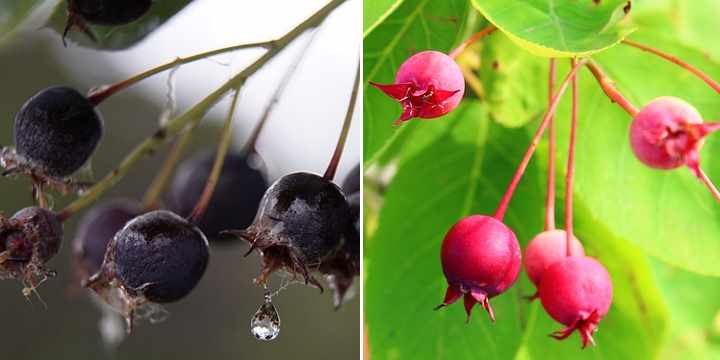
Serviceberry fruit. Left picture: mature purple serviceberry fruits. Right picture: immature red serviceberry fruits.
Serviceberry shrubs and trees produce edible purple berry-like pome fruits when mature. The small, round serviceberry fruits grow in small drooping clusters. Fruits on serviceberry trees measure 0.4” (1 cm). The sweet, tasty serviceberry fruits taste like blueberries and are a popular ingredient for jams and jellies.
Types of Serviceberry Trees
Let’s look in more detail at the identifying features of popular varieties of serviceberry trees.
Autumn Brilliance Apple Serviceberry Tree (Amelanchier × grandiflora ‘Autumn Brilliance’)
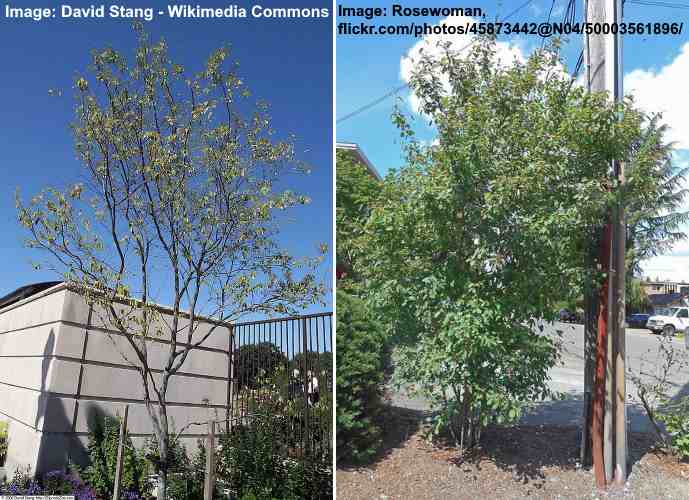
Autumn Brilliance serviceberry tree grows as a multi-stemmed tree but you can remove suckers to prevent a shrubby growth
The ‘Autumn Brilliance’ serviceberry tree (Amelanchier × grandiflora) is a hybrid that blooms in April with clusters of white starry flowers. The spectacular feature of this deciduous tree is its brilliant orange and red fall colors before the leaves drop. During spring, the edible tiny apple-like fruits (juneberries) begin to form, ultimately becoming purple in June.
‘Autumn Brilliance’ serviceberry grows between 20 and 25 ft. (6 – 7.5 m) tall and 15 to 20 ft. (4.5 – 6 m) wide. In garden landscapes, serviceberry ‘Autumn Brilliance’ thrives in USDA zones 3 to 8 and performs best in full sun to partial shade.
‘Autumn Brilliance’ serviceberry tree (Amelanchier × grandiflora) is a cross between Amelanchier arborea (downy serviceberry) and Amelanchier laevis (Allegheny serviceberry). It’s a multi-stemmed tree that sends up suckers. So, to grow the apple serviceberry as a tree, it’s vital to remove suckers to prevent it from developing into a bushy shrub.
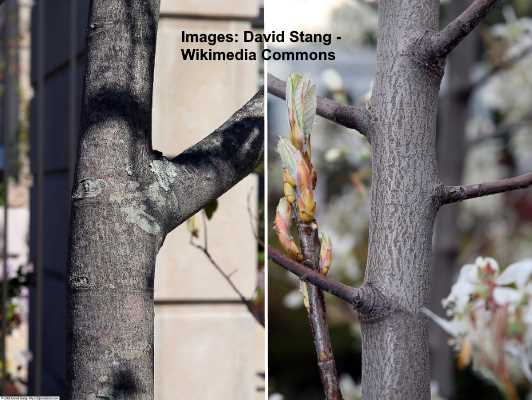
Autumn Brilliance serviceberry bark
To care for an ‘Autumn Brilliance’ serviceberry tree, ensure it gets at least six hours of sunlight daily. Grow serviceberry trees in well-drained, loamy soil. Once established, the apple serviceberry tree requires minimal care and is a relatively drought-tolerant tree. Just remove suckers if you don’t want it to grow as a shrub.
With the proper pruning, you can grow the ‘Autumn Brilliance’ serviceberry tree as a foundation planting, specimen tree, shade tree, or tall flowering border shrub.
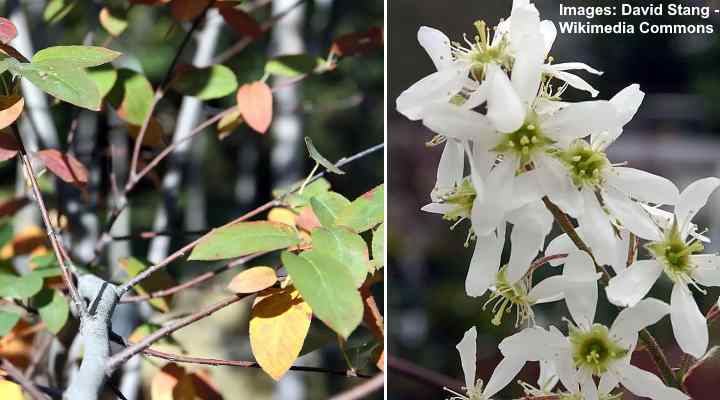
Autumn Brilliance serviceberry leaves and flowers
Serviceberry leaves: Ovate to elliptical-shaped leaves with finely toothed edges measuring up to 3” (7.5 cm) long. The serviceberry leaves turn from green to red and orange in the fall.
Serviceberry flowers: Clusters of white or pinkish-white flowers that bloom in early spring. The individual fragrant flowers each have five petals.
Serviceberry fruit: Small edible berry-like fruits that are red and ripen to purple during summer.
USDA growing zones: 3 to 8.
Serviceberry tree height: 20 to 25 ft. (6 – 7.5 m) tall and 15 to 20 ft. (4.5 – 6 m) wide.
Sun exposure: Full sun to partial shade.
Allegheny serviceberry (Amelanchier laevis)
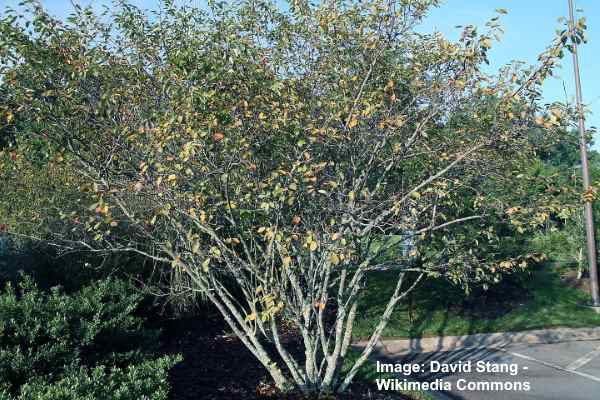
Allegheny serviceberry (Amelanchier laevis) tree
The Allegheny serviceberry (Amelanchier laevis) is the tallest native tree in the genus Amelanchier. The distinguishing feature of the Allegheny serviceberry is its hairless leaves that emerge purple before turning green. In the fall, Allegheny serviceberry trees turn golden-yellow to warm red.
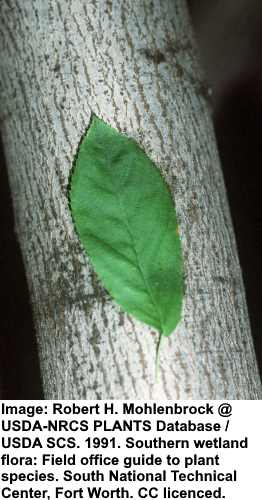
Allegheny serviceberry bark and leaf
Allegheny serviceberry has smooth, gray bark with white stripes running longways. As the serviceberry matures, the gray bark becomes darker and rougher with some fissuring. Its brown or copper stems produce ovate leaves, pretty, fragrant white flowers. The edible berry like fruit is purple when mature.
Due to its hairless leaves, the Allegheny serviceberry goes by the name smooth serviceberry, smooth shadbush, or smooth-leaved serviceberry.
Allegheny serviceberry trees thrive in USDA zones 4 to 8. The Amelanchier laevis species is shade tolerant and grows well in dappled sunlight or full sun.
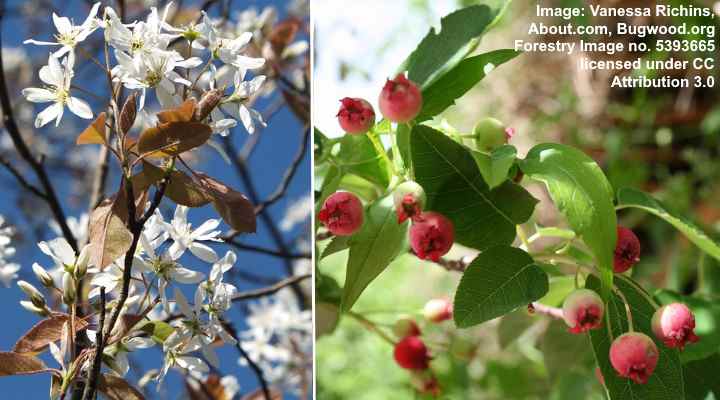
Allegheny serviceberry flowers, leaves and fruit
Serviceberry leaves: Oval leaves with serrated margins that measure 2” to 4” (5 – 10 cm) long and 2” (5 cm) wide. The dark green leaves turn reddish-orange in the fall.
Serviceberry flowers: White, showy flowers with five petals.
Serviceberry fruit: Allegheny serviceberry has small round fruits that turn from red to purple as they mature. Compared to other varieties of serviceberries, the Allegheny serviceberry fruit is the sweetest and tastiest
USDA growing zones: 4 to 8.
Serviceberry tree height: 15 to 40 ft. (4.5 – 12 m) tall and wide.
Sun exposure: Full sun to partial shade.
Shadblow Serviceberry Tree (Amelanchier canadensis)
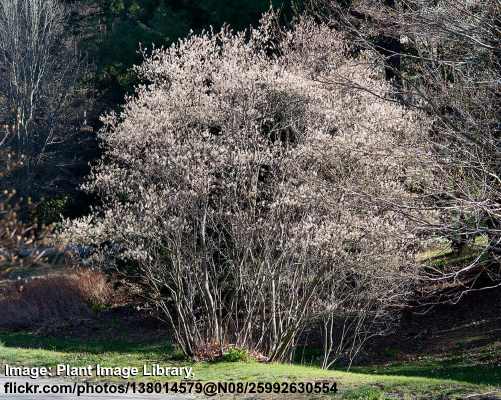
Shadblow serviceberry tree (Amelanchier canadensis)
The shadblow serviceberry (Amelanchier canadensis) is a small tree that produces clusters of pinkish-white flowers when it blooms in March. Like all serviceberry species, the shadblow produces dark green, finely-toothed oblong leaves, showy flowers, and edible purple berries. The serviceberry tree has smooth bark that develops furrows as it matures.

Bark of a mature Shadblow serviceberry tree
Other names for shadblow serviceberry include Canadian serviceberry and thicket serviceberry.
Shadblow serviceberry trees grow best in USDA zones 3 to 8. In warmer regions, the berry-producing tree thrives in partial shade and moist soil. However, in colder climates, it can withstand some drought.
To grow the shrub-like serviceberry plant as a specimen tree, remove the suckers in winter. The beautiful tree develops a dome-shaped crown that fills with delicate aromatic flowers in early spring.

Shadblow serviceberry flowers and leaves
Serviceberry leaves: Simple medium to dark green leaves, elliptical to oblong in shape with serrated edges. The serviceberry leaves measure 3” (7.5 cm) long and 1” (2.5 cm) wide. In the fall, shadblow serviceberry leaves turn orange-red.
Serviceberry flowers: Fragrant serviceberry white flowers emerge from pink buds in early spring. The five petals form a fan out from the center, creating a star shape. The white serviceberry flowers grow in clusters in March and April.
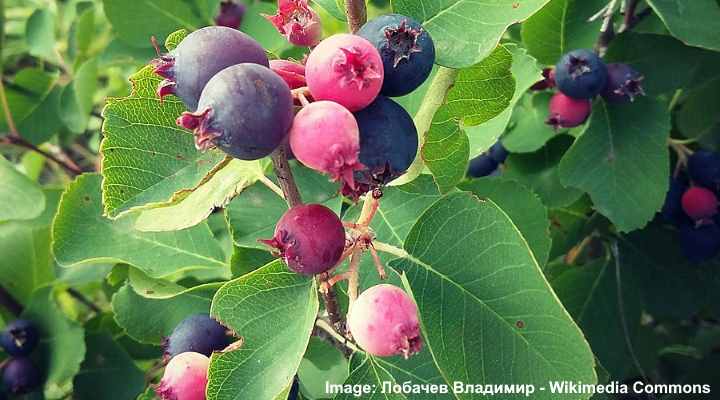
Shadblow serviceberry fruit
Serviceberry fruit: Shadblow serviceberry grows edible fruits that emerge green and turn red before maturing to purple-black. The delicious berry-like pomes are ready for picking in May and June.
USDA growing zones: 3 to 8.
Serviceberry tree height: 15 to 25 ft. (4.5 – 7.5 m) tall and up to 20 ft. (6 m) wide.
Sun exposure: Full sun with some afternoon shade.
Rainbow Pillar Serviceberry (Amelanchier canadensis ‘Glenn Form’)

Rainbow Pillar Serviceberry tree (Amelanchier canadensis ‘Glenn Form’)
‘Rainbow Pillar’ is a serviceberry tree cultivar with small white five-petaled flowers, edible dark purplish-black fruits, and dense leafy foliage. One of the attractive features of this serviceberry tree is its upright, symmetrical growth habit. The ‘Rainbow Pillar’ serviceberry grows 15 to 20 ft. (4.5 – 6 m) tall and 10 ft. (3 m) wide.
The ‘Rainbow Pillar’ serviceberry grows best in USDA zones 4 to 7. It’s an adaptable tree that grows well in most soils and can withstand soggy soil or dry soil.
The white clusters of flowers bloom in March or April before the dark green leaves emerge. In the fall, the serviceberry’s foliage turns warm orange and red hues. Dark, purplish fruit adorn the ornamental tree in early summer.
Juneberry (Amelanchier lamarckii)
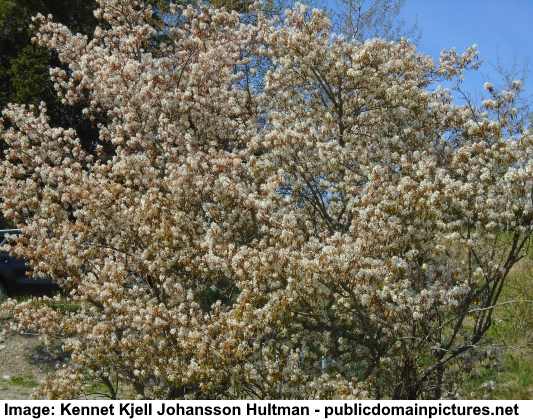
Juneberry (Amelanchier lamarckii) tree
Juneberry (Amelanchier lamarckii) is also called snowy mespilus, and it’s a small tree with a spreading, vase-shaped crown. Small clusters of white five-petaled flowers appear along with the leaves in early spring. The dark-green, finely serrated ovate leaves turn spectacular shades of orange and red in the fall. The edible dark purple berries appear in June.
Juneberry trees grow 15 to 25 ft. (4.5 – 7.5 m) tall and wide and thrive in USDA zones 4 to 8.
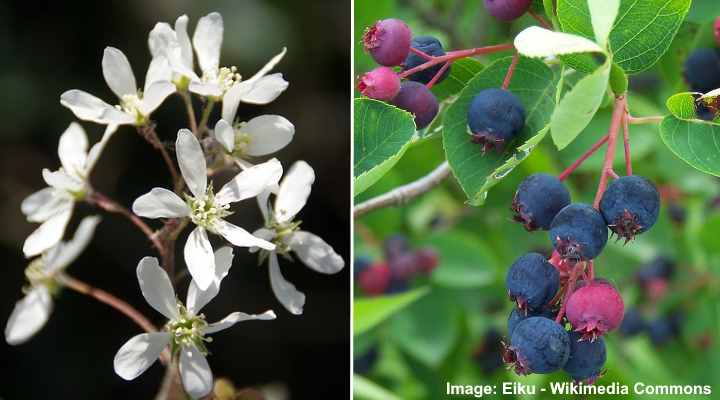
Juneberry flowers, fruit and leaves
Downy Serviceberry (Amelanchier arborea)
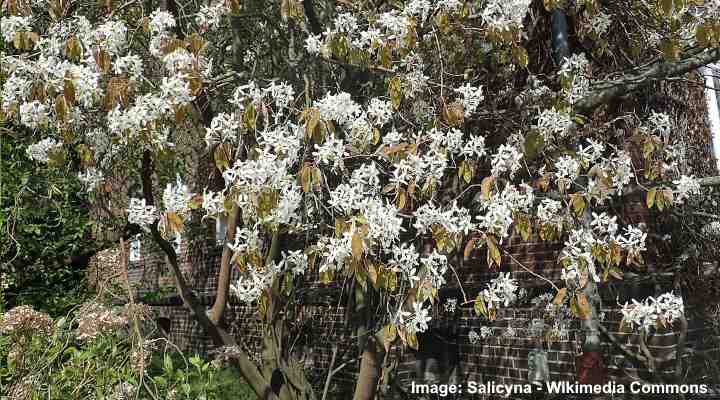
Downy serviceberry (Amelanchier arborea)
The downy serviceberry (Amelanchier arborea) is a deciduous, multi-stemmed small flowering tree or large shrub with a narrow, rounded form. The common name—downy serviceberry—comes from the fuzzy green leaves with serrated margins. As an ornamental small tree or large shrub, the downy serviceberry is prized for its beautiful showy flower clusters and pretty purple berries.
Downy serviceberry trees thrive in full sun or partial shade in USDA zones 4 to 9. It’s a low-maintenance landscaping tree that tolerates a wide range of soils. Like most serviceberry trees, it has minimal watering needs.
Downy serviceberry trees grow 15 to 25 ft. (4.5 – 7.5 m) tall and 4 to 8 ft. (1.2 – 2.4 m) wide. Like all serviceberries, the downy serviceberry species provides all-year interest.
Downy serviceberry trees grow showy white flowers that blossom in spring, followed by dark-green leaves. Clusters of edible purplish-black berries add to the shrub’s summer interest. In fall, the serviceberry leaves transform into bright shades of yellow, orange, and red. In winter, its ornamental value is light gray bark with long darker stripes.
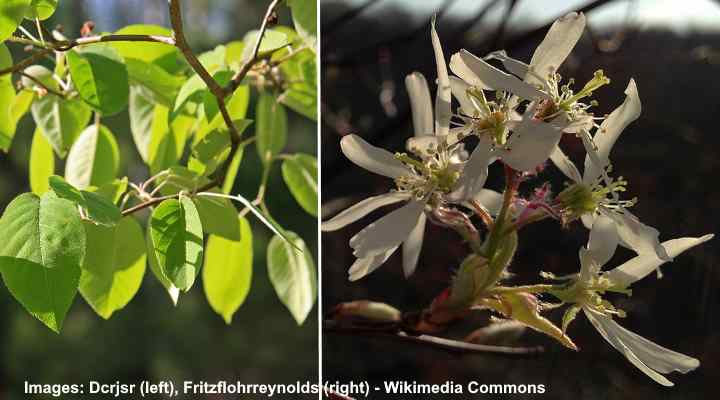
Downy serviceberry leaves and flowers
Serviceberry leaves: The leaves are obovate or egg-shaped with light serration on the edges. Woolly hairs cover the new leaves, and they become smoother as they mature. In the fall, the rich green leaves become shades of yellow, orange, and red.
Serviceberry flowers: White flower clusters appear early on serviceberry shrubs. The five-petaled star-shaped flowers have a mild fragrance and measure around an inch (2.5 cm) and dangle in 4-inch (12 cm) long clusters.
Serviceberry fruit: Small clusters of berry-like pomes are ready for eating in June. The fruits are purplish-black when ripe.
USDA growing zones: 4 to 9
Serviceberry shrub height: Matures at 15 to 25 ft. (4.5 – 7.5 m) tall and 4 to 8 ft. (1.2 – 2.4 m) wide.
Sun exposure: Full sun to light shade.
Types of Serviceberry Shrubs
Serviceberry shrubs are beautiful multi-stemmed plants that grow well in most garden landscapes. Here are descriptions and pictures of the most common serviceberry shrubs.
Saskatoon Serviceberry (Amelanchier alnifolia)
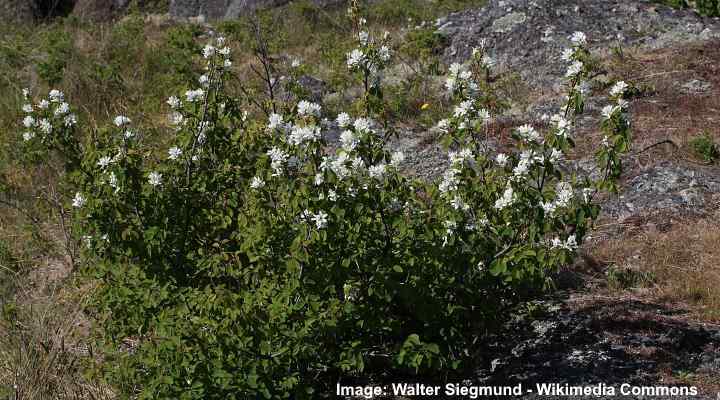
Saskatoon Serviceberry (Amelanchier alnifolia) shrub
The Saskatoon serviceberry (Amelanchier alnifolia) is a large, upright shrub with light gray bark, white flower clusters, oval leaves, and red or purple-blue berries. As a decorative landscape shrub, the Saskatoon serviceberry is suitable as a flowering hedge, foundation planting, specimen plant, or deciduous screen.
Like most serviceberry shrubs, the suckering plant adapts well to most conditions. The shrub is relatively drought-tolerant but also thrives in moist soil. Growing in full sun produces the best and tastiest berries and outstanding orange or red fall foliage colors.
Other common names for the Saskatoon serviceberry include pigeon berry, western serviceberry, and western shadbush.
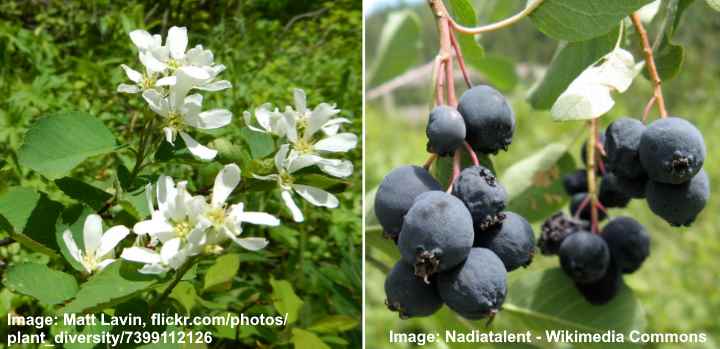
Saskatoon serviceberry flowers, leaves and fruit
Serviceberry leaves: The leaves are smaller than typical serviceberry leaves, have coarsely-toothed margins, and are oval-shaped. The light green leaves on this serviceberry shrub turn magnificent shades of reds and oranges in the fall.
Serviceberry flowers: Like most serviceberry flowers, the clusters of blossoms have star-shaped white flowers with five petals.
Serviceberry fruit: Clusters of sweet dark purple or blue berries ripen in summer and attract birds. The tasty pomes are delicious in jellies and jams.
USDA growing zones: 4 to 9.
Serviceberry shrub height: 3 ft. to 18 ft. (1 – 5.5 m) tall and 6 to 10 ft. (2.4 – 3 m) wide.
Sun exposure: Full sun to partial shade.
Regent Serviceberry (Amelanchier alnifolia ‘Regent’)
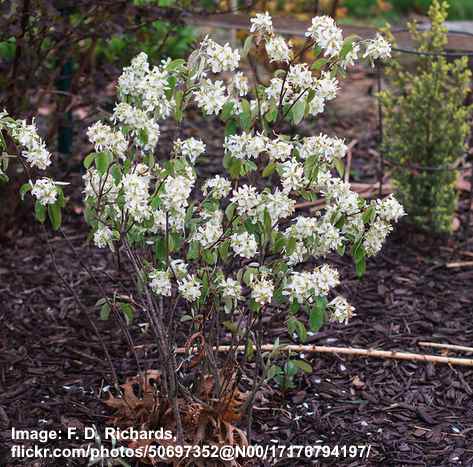
Regent serviceberry
The ‘Regent’ serviceberry is a compact cultivar of the saskatoon serviceberry. This flowering shrub matures at 3 to 6 ft. (1 – 1.8 m) tall and wide. The bluish-green ovate leaves turn golden yellow and deep red in the fall. Its four-season interest is also due to its attractive light gray bark with charcoal-gray shallow furrows.
Serviceberry ‘Standing Ovation’ (Amelanchier alnifolia ‘Obelisk’)
The ‘Standing Ovation’ serviceberry shrub is a Saskatoon cultivar. The narrow, upright white-flowering shrub grows 15 ft. (4.5 m) tall and 4 ft. (1.2 m) wide. The primary ornamental value of this shrub is its decorative fruit which emerge as green berries, turn red, and ripen to purple berries.
In garden landscapes, the ‘Standing Ovation’ serviceberry is a shrub suitable for hedges, screening, an accent plant, or corner of the house shrub.
Dwarf Serviceberry Shrub (Amelanchier spicata)
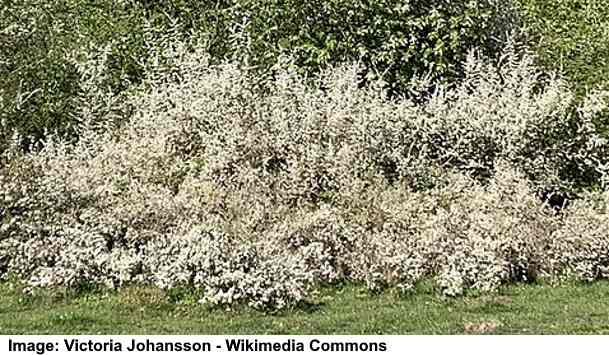
Dwarf Serviceberry shrubs (Amelanchier spicata)
The dwarf serviceberry shrub (Amelanchier spicata) is a low-growing deciduous flowering plant that grows 3 to 5 ft. (1 – 1.5 m) tall and wide. White showy flowers growing in clusters are some of the first to bloom in spring gardens. Its leaves are elliptical and turn golden yellow or orange in the fall.

Dwarf serviceberry flowers, leaves and fruit
The dwarf serviceberry shrub thrives in USDA zones 4 to 8 and full sun to partial shade. The multi-stemmed shrub grows as a hedge or screen and has four-season ornamental value.
Utah Serviceberry Shrub (Amelanchier utahensis)

Utah serviceberry shrub (Amelanchier utahensis)
The Utah serviceberry (Amelanchier utahensis) is a large shrub with all the characteristic features of serviceberry plants. The spreading shrub grows up to 16 ft. (5 m) tall and has a rounded shape. Clusters of dainty white flowers appear in mid-April, followed by red berries that ripen to dark purple.
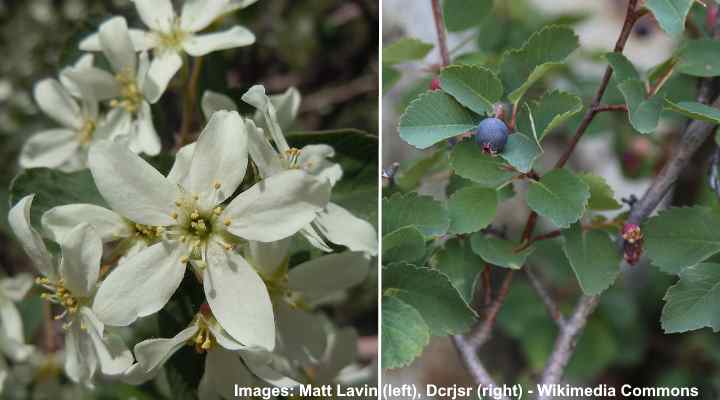
Utah serviceberry flowers, leaves and fruit
Related articles:
